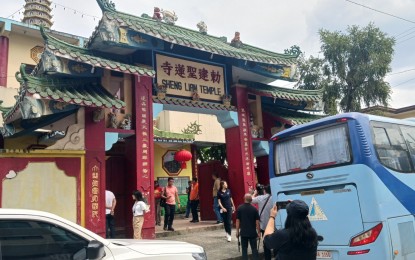
QC CHINATOWN. Gates of the Sheng Lian Temple in Banawe welcome visitors taking part in Quezon City's first ever heritage tour for its three-day Chinese New Year celebration, on Friday (Feb. 9, 2024). The QC government is promoting its Banawe Chinatown as a tourism hub, which QC Mayor Joy Belmonte said could be an alternative to Manila's Binondo. (PNA photo by Marita Moaje)
MANILA – Binondo's Chinatown is probably the country's most popular one. But did you know that Quezon City has its own Chinatown, which at 591.9 hectares is said to be one of the largest in the world?
For this Chinese New Year, this area could be the perfect alternative place to immerse oneself in Chinese culture and customs.
That is why during the very first heritage tour organized by the QC government, Mayor Joy Belmonte said they are pushing for the Banawe Chinatown, home to a number of temples, as a tourism hub.
“Ang layunin nito ay maengganyo ang mga QCitizens pati na rin yung mga hindi taga Quezon City na kapag gusto nilang ma experience ang authentic Chinese and Filipino culture ay alternatibo ang Banawe o Quezon City's Chinatown sa Binondo Chinatown sa Maynila (The aim is to encourage QCitizens and even those from outside QC that if they want to experience authentic Chinese and Filipino culture, Banawe, of the Quezon City’s Chinatown, is an alternative to Manila’s Binondo),” Belmonte said.
Various media organizations as well as food vloggers were invited to the heritage tour, which included the Tzu Chi Foundation, the Sheng Lian Temple, the Filipino-Chinese Friendship Arch, and the Wow Toy Museum.
Meanwhile, dimsum, siopao and noodles are just among the Chinese delicacies famous not only to Chinese but to Filipinos as well.
To promote authentic Chinese food, select Chinese restaurants were also visited to promote the city’s “culinary gems”, still located in the Chinatown district in Banawe.
By visiting the city’s Chinatown, Belmonte said Filipinos can deepen their knowledge of the rich Chinese tradition, which includes its food.
Belmonte said the tour is just to give a taste of what is yet to come in the city as they also prepare to make it a regular feature in the city, and later on, even facilitate tours for visitors.
The Banawe Chinatown can also help the city’s local economy, she said.
“Hopefully, if people choose to come here, ma-iimprove ang local economy natin, magkakaron ng negosyo ang mga restaurant at syempre kapag may mga tourism destination pa na pwedeng puntahan, bonus na yan, so hindi lang pagkain ang inoofer natin, pati cultural experiences (the local economy will improve, restaurant will have business, and of course, if there are tourism destination that may be visited, that is already a bonus, so we are offering not only foods, but cultural experience as well),” she said.
QC has prepared for a three-day celebration of this year’s Chinese New Year with activities that include a food, arts, and crafts fair, lion and dragon dance, Chinatown, float parade, Chinese calligraphy and painting demonstration, and a Chinatown Heritage bike tour.
The city is expecting about 100,000 tourists for this event. (PNA)
